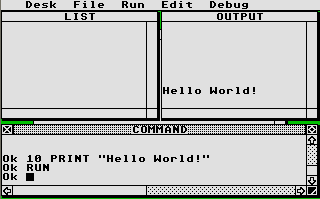 When we think of Atari, the first image that often comes to mind is that of classic gaming consoles like the Atari 2600, which pioneered the home video game industry in the late 1970s. However, there's another side to Atari's legacy that often goes unnoticed by many: its line of personal computers. Despite not receiving as much recognition as its gaming consoles, Atari's foray into the personal computer market left a lasting impact on the industry. In this article, we'll take a closer look at Atari's lesser-known venture into personal computing and why it's worth remembering.
When we think of Atari, the first image that often comes to mind is that of classic gaming consoles like the Atari 2600, which pioneered the home video game industry in the late 1970s. However, there's another side to Atari's legacy that often goes unnoticed by many: its line of personal computers. Despite not receiving as much recognition as its gaming consoles, Atari's foray into the personal computer market left a lasting impact on the industry. In this article, we'll take a closer look at Atari's lesser-known venture into personal computing and why it's worth remembering.
The Birth of Atari Computers
 In the early 1980s, amidst the burgeoning home computer revolution, Atari decided to enter the personal computer market. In 1985, Atari introduced the Atari ST series, which would become the company's flagship line of personal computers. The Atari ST (which stands for "Sixteen/Thirty-two," referring to its 16-bit external bus and 32-bit internal architecture) was positioned as a competitor to popular machines like the Apple Macintosh and the Commodore Amiga.
In the early 1980s, amidst the burgeoning home computer revolution, Atari decided to enter the personal computer market. In 1985, Atari introduced the Atari ST series, which would become the company's flagship line of personal computers. The Atari ST (which stands for "Sixteen/Thirty-two," referring to its 16-bit external bus and 32-bit internal architecture) was positioned as a competitor to popular machines like the Apple Macintosh and the Commodore Amiga.
Features and Innovations
 Despite being overshadowed by its competitors, the Atari ST boasted several notable features and innovations. One of its standout features was its built-in MIDI (Musical Instrument Digital Interface) ports, which made it a favorite among musicians and music producers. The Atari ST's MIDI capabilities helped it gain widespread adoption in the music industry, where it was used for everything from composing and sequencing to recording and editing.
Despite being overshadowed by its competitors, the Atari ST boasted several notable features and innovations. One of its standout features was its built-in MIDI (Musical Instrument Digital Interface) ports, which made it a favorite among musicians and music producers. The Atari ST's MIDI capabilities helped it gain widespread adoption in the music industry, where it was used for everything from composing and sequencing to recording and editing.
Additionally, the Atari ST offered impressive graphics and sound capabilities for its time, thanks to its custom graphics and sound chips. Its graphical user interface (GUI), known as GEM (Graphics Environment Manager), provided a user-friendly experience that rivaled those of competing systems.
Legacy and Impact
 While Atari's venture into personal computing may not have achieved the same level of commercial success as its gaming consoles, it left a lasting legacy in several key areas. The Atari ST's influence on the music industry cannot be overstated, as it played a significant role in the development of electronic music and digital audio production. Many iconic albums and soundtracks from the 1980s and 1990s were composed and produced using Atari ST computers.
While Atari's venture into personal computing may not have achieved the same level of commercial success as its gaming consoles, it left a lasting legacy in several key areas. The Atari ST's influence on the music industry cannot be overstated, as it played a significant role in the development of electronic music and digital audio production. Many iconic albums and soundtracks from the 1980s and 1990s were composed and produced using Atari ST computers.
Furthermore, the Atari ST's graphical capabilities and user-friendly interface paved the way for future innovations in computing and helped shape the evolution of modern operating systems and software applications.
Rediscovering Atari's Computing Legacy
 Despite its relative obscurity compared to its gaming consoles, Atari's line of personal computers remains a fascinating chapter in the history of computing. Whether you're a music enthusiast, a vintage computing aficionado, or simply curious about the lesser-known corners of tech history, exploring Atari's computing legacy can provide valuable insights into the evolution of personal computing and its cultural impact.
Despite its relative obscurity compared to its gaming consoles, Atari's line of personal computers remains a fascinating chapter in the history of computing. Whether you're a music enthusiast, a vintage computing aficionado, or simply curious about the lesser-known corners of tech history, exploring Atari's computing legacy can provide valuable insights into the evolution of personal computing and its cultural impact.
In conclusion, while Atari may be best known for its iconic gaming consoles, its contributions to the world of personal computing should not be overlooked. The Atari ST series, with its innovative features and lasting legacy, stands as a testament to Atari's enduring influence on the technology landscape.